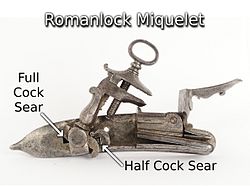



Miquelet lock is a modern term used by collectors and curators for a type of firing mechanism used in muskets and pistols. It is a distinctive form of snaplock, originally as a flint-against-steel ignition form, once prevalent in the Spanish, Portuguese, and Ottoman empires, Italy, Greece, Russia, Ukraine, North Africa, and the Balkans from the late 16th to the mid-19th century.
The term miquelet lock was not recorded until the 19th century, long after the appearance of the mechanism in the 16th century, and is of uncertain origin. One commonly held view is that it was coined by British troops in the Peninsular War to describe the style of musket used by the Miquelet (militia) that had been assigned to the Peninsular Army of the Duke of Wellington.[1] In most of Spain, it was traditionally called the llave de rastrillo ("rake lock"), and in Catalonia and Valencia it was called the pany de pedrenyal ("flint-lock") or simply pedrenyal ("flint").
There is often confusion, or at least a difference of opinion, as to what constitutes a snaplock, snaphaunce, miquelet and a flintlock. The term flintlock was, and still is, often applied to any form of friction (flint) lock other than the wheellock with the various forms sub-categorized as snaphaunce, miquelet, English Doglock, Baltic Lock, and French or "true" flintlock ("true" being the final, widely used form). Strictly speaking, all are flintlocks. However, current usage demands the separation of all other forms of flintlock from the so-called "true flintlock".[2]